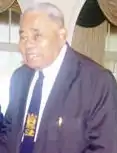| Vice-President of the Republic of Fiji | |
|---|---|
 Coat of arms of the Republic of Fiji | |
| Appointer | Great Council of Chiefs (1990–2009) President of Fiji (2009–13) |
| Formation | 1990 |
| First holder | Josaia Tavaiqia Inoke Takiveikata |
| Final holder | Epeli Nailatikau |
| Abolished | 6 September 2013 (permanently vacant since July 30, 2009) |
| Superseded by | Chief Justice of Fiji |
 |
|---|
The position of the vice-president of the Republic of Fiji was created in 1990, to provide a constitutional successor to the president of Fiji, in the event of the latter's death or resignation, or of his otherwise being unable to carry out his duties. The vice-president's role in government was mostly ceremonial as its sole purpose was to replace the president in his absence, death, or inability to hold office. The vice-presidency was abolished in 2013, with the powers of the office transferred to the Chief Justice of Fiji, who has a dormant commission which is triggered when the position of President of Fiji is either vacant or when the President is either absent or ill.
History of the office
Under the terms the 1990 Constitution of Fiji, the vice-presidency was divided between two persons, styled First Vice-President and Second Vice-President, respectively, but a single person held the office of vice-president from 1999, when the 1997 Constitution of Fiji came into effect.
Under the terms of the 1997 Constitution, the vice-president was appointed by the Great Council of Chiefs, after consultation with the prime minister.[1] In April 2009, however, the Constitution was suspended, following the earlier suspension of the Great Council of Chiefs in April 2007. Six days after the suspension of the Constitution, the government issued a decree stating that the vice-president would henceforth be appointed by the president.[2] Ratu Epeli Nailatikau was appointed vice-president the following day.[3]
Under the terms of the 2013 Constitution, the vice-presidency was abolished, with its duties and powers transferred to the chief justice.[4]
Being appointees of the all-indigenous Great Council of Chiefs, Fiji's vice-presidents, like its presidents, have all been indigenous Fijians (of chiefly rank). In 2007, Reverend Akuila Yabaki, Director of the Citizens Constitutional Forum, suggested that "the time may be right now to allow a person from any race to take up this position".[5]
Vice-presidents
First vice-presidents
Second vice-presidents
| ||||||||||||||||||||||||||||||||||||||||||||||||||||||||||||||||||||||||||||||||||||||||
Vice-presidents (single office)
| No. | Portrait | Vice-President | Took office | Left office | Time in office | Party | President |
|---|---|---|---|---|---|---|---|
| Ratu Josefa Iloilo (1920–2011) | 18 January 1999 | 29 May 2000 | 1 year, 132 days | Independent | Ratu Sir Kamisese Mara | ||
| Vacant (29 May 2000 – 25 March 2001) | |||||||
| Ratu Jope Seniloli (1939–2015) | 25 May 2001 | 29 November 2004 | 3 years, 188 days | Independent | Josefa Iloilo | ||
| Ratu Joni Madraiwiwi (1957–2016) | 15 December 2004 | 5 December 2006 | 1 year, 355 days | Independent | Josefa Iloilo | ||
| Vacant (5 December 2006 – 17 April 2009) | |||||||
| Ratu Brigadier general (Rtd) Epeli Nailatikau (born 1941) | 17 April 2009 | 30 July 2009 | 104 days | Independent | Josefa Iloilo | ||
| Vacant (30 July 2009 – 6 September 2013) | |||||||
| Abolished (6 September 2013 – present) | |||||||
References
- ↑ Constitution of Fiji, s.90
- ↑ Office of the Vice-President and Succession Decree Archived 13 September 2009 at the Wayback Machine, 16 April 2009
- ↑ "Fiji appoints Ratu Epeli Nailatikau as Vice President", Radio Australia, 17 April 2009
- ↑ "No Vice President for Fiji: PM".
- ↑ "Promote multi-racism in Fiji", Fiji Broadcasting Corporation, 30 December 2007



